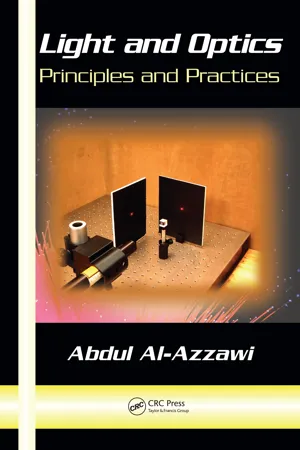Physics
Light Prism
A light prism is a transparent optical element with flat polished surfaces that can refract, reflect, and disperse light. When light enters a prism, it is bent or refracted, and different colors of light are separated due to their varying wavelengths, creating a spectrum. This phenomenon is key to understanding the dispersion of light and the formation of rainbows.
Written by Perlego with AI-assistance
Related key terms
Related key terms
1 of 4
Related key terms
1 of 3
5 Key excerpts on "Light Prism"
- eBook - ePub
Light and Optics
Principles and Practices
- Abdul Al-Azzawi(Author)
- 2018(Publication Date)
- CRC Press(Publisher)
11 Prisms 11.1 INTRODUCTIONThe purpose of this chapter is to explain the basic principles that govern light passing through a prism or a combination of prisms. Types of prisms and image formation are also presented. The concept of light passing through prisms is very important to photonics and has significant use in image formation and building optical devices. Particular emphasis will be given to calculating the index of refraction of a prism, producing a rainbow of colours, and mixing a rainbow of colours using a glass rod or tube. Also in this chapter, along with the theoretical presentation, five experimental cases demonstrate the principles of light passing through prisms.11.2 PRISMSPrisms are blocks of optical material with flat polished faces arranged at precisely controlled angles, as shown in the figure above. In many situations it is necessary to direct a beam of light entering from one side and exiting from the other side of the prism. Light passing through prisms is governed by the laws of light.Prisms are widely used in building optical devices, such as a prism spectrometer, which is commonly used to study the wavelengths emitted by a light source. Prisms are also used in building optical fibre devices, such as an opt-mechanical switch, which deflects or deviates an optical signal through a telecommunication system. Prisms can invert or rotate an image, deviate a light beam, disperse light into its component wavelengths, and separate states of polarization. The orientation of a prism (with respect to the incident light beam) determines its effect on the beam. Prisms can be designed for specific applications. The most popular prisms are right angle prisms, Brewster’s angle dispersing prisms, Penta prisms, solid glass retro-reflectors, equilateral dispersing prisms, littrow dispersion prisms, wedge prisms, roof prisms, and Dove prisms. Some of these commonly used prisms are discussed in detail in this chapter. - eBook - ePub
- Stephen Rolt(Author)
- 2019(Publication Date)
- Wiley(Publisher)
11 Prisms and Dispersion Devices11.1 Introduction
In studying the interaction of light and matter, we frequently wish to understand how this behaviour changes as a function of wavelength. We might wish, for instance, to view the spectrum emitted by a lamp or the solar spectrum with atomic absorption lines superimposed thereon. For a variety of reasons, we might wish to decode the spectral information in incident light and present this (usually) as a spatially dispersed spectrum. In this scenario, a beam of light is spatially dispersed in such a way as to present a specific wavelength of light at a unique spatial location. Of course, historically, the ‘splitting of light into its constituent colours’ was accomplished, as in the case of Newton, by means of a prism. The refractive index variation of glasses with wavelength, or dispersion, produces a variation in the refracted angle with wavelength and results in spatial dispersion of the light with respect to wavelength. However, the degree of angular dispersion produced by prisms is disappointingly small. As a result, prisms feature little in practical spectroscopic instruments. They have more or less wholly been displaced by devices that rely on diffraction, such as diffraction gratings.Notwithstanding these considerations, we will commence this narrative with a consideration of dispersive prisms. Understanding the limitations of these components will enable their diffractive counterparts to be placed into proper context in modern applications.11.2 Prisms
11.2.1 Dispersive Prisms
Before examining in detail the behaviour of modern diffractive components, we will consider very briefly the dispersive properties of a simple prism. In this elementary discussion we will consider the operation of a prism that is established under the so-called minimum deviation condition. In this scenario, the incidence angle at the first interface is equal to the refracted angle at the second prism interface. That is to say, the arrangement is entirely symmetrical, with an angle of incidence of θ and an apex angle α. This arrangement is shown in Figure 11.1 - eBook - ePub
- Daniel Malacara Hernández(Author)
- 2017(Publication Date)
- CRC Press(Publisher)
6Prisms and RefractiveOptical Components
6.1PrismsDaniel Malacara-Hernández and Duncan T. MooreDeflecting Prisms • Retroreflecting Prisms • Inverting and Reverting Prisms • Rotating Prisms • Beamsplitting Prisms • Chromatic Dispersing Prisms6.2LensesSingle Thin Lenses • Thick Lenses and Systems of Lenses • Thick Lenses • System of Two Separated Thin Lenses • Aspheric Lenses • Fresnel Lenses6.3Gradient Index OpticsAxial Gradient Index Lenses • Radial Gradient Index Lenses6.4Summary References6.1Prisms
In this chapter, we will describe only prisms made out of isotropic materials, such as glass or plastic [1 ,2 ]. There are two kinds of prisms: prisms that produce chromatic dispersion of the light beam and prisms that only deflect the light beam, changing its traveling direction and image orientation. Deflecting prisms usually make use of total internal reflection, which occurs only if the internal angle of incidence is larger than the critical angle (about 41°) for a material whose index of refraction is 1.5. If an internal reflection is required with internal angles of incidence smaller than the critical angle, the surface has to be coated with silver or aluminum.A deflecting prism or system of plane mirrors does not only deflect the light beam but also changes the image orientation [3 –6 - eBook - ePub
- R.A. Edwards(Author)
- 2014(Publication Date)
- Pergamon(Publisher)
Chapter 21 .If a beam of white light such as that from the sun or from an ordinary electric filament lamp is refracted through a glass prism dispersion occurs and the different colour components of the light emerge from the prism travelling in slightly different directions from each other. It was in this way that Newton discovered in the seventeenth century that white light consisted of a spectrum of colours. He made a small hole in a window blind through which sunlight passed producing a bright, illuminated circular patch on a screen placed in its path. When a prism was placed between the hole and the screen, in the path of the light, deviation of the light occurred but also the patch of light was considerably elongated and there was a variation in colour from one end to the other, the least deviated light being red and the most deviated being violet, as shown in Fig 23.1 . Newton distinguished seven colours—the colours of the rainbow—red, orange, yellow, green, blue, indigo and violet. A spectrum obtained in this simple manner is not a “pure” spectrum since the various colours overlap. Figure 23.2 shows an arrangement in which a pure spectrum may be obtained on a screen so that there is minimum overlapping of colours and as one progresses from the red to the violet there is a continuous decrease in the wavelength of the light incident at any point. A suitable source of light is an ordinary electrically heated filament lamp and this is used to illuminate a narrow slit. The slit is situated in the focal plane of a converging lens L which, for reasons to be explained later, should preferably be a combination of a converging lens and a diverging lens of different refractive indices and in contact with each other, such a combination being known as an achromatic lens or achromatic doublet , designed so as to produce no dispersion. The light from each point of the slit thus emerges as a parallel beam. The light is said to be collimated and the lens acts as a collimator . This light then falls on one face of the prism where dispersion occurs and the emergent light consists of sets of parallel beams of light travelling in different directions and of different colours, i.e. wavelengths, from each point of the slit. A second converging achromatic lens L′ - eBook - ePub
- R M MARSTON(Author)
- 1999(Publication Date)
- Newnes(Publisher)
dispersion.Figure 9.16 Exaggerated diagram showing a prism splitting a beam of white light into its component coloursWhen a ray of light passes through air and enters a prism, it bends by an amount determined by its angle of incidence and by the refractive index value of the glass. When the ray leaves the prism again and returns to the air, it bends by an amount determined by its angle of incidence and by the refractive index of the air (1.0) divided by that of the glass (say 1.5), and this value is invariably less than zero (0.667 in this example). Figure 9.17 shows the actual amounts of output refraction that occur on three different prisms that each have a refractive index of 1.5.Figure 9.17 Diagram illustrating the phenomenon of total internal reflection in a prismIn Figure 9.17 , the ray strikes the output surface of prism A at an incident angle of 30° and leaves the prism at a refractive angle of 42°; this prism thus bends the ray downwards by 12°. In the case of prism B, the ray strikes its output surface at an incident angle of 40° and leaves at a refractive angle of 85°, thus bending the ray downwards by 45°.Note in the case of prism B that the ray leaves the prism at an angle that is only 5° less than the angle of slope of the prism’s output face, and it is obvious that if the angle of incidence is increased much more the ray will be unable to penetrate the prism’s output surface. The angle of incidence at which this occurs is known as the surface’s critical angle , and is dictated by the n value of the glass; the critical angle is 43° at an n value of 1.5, 36° at an n value of 1.7, and 32° at an n value of 1.9.Figure 9.17 shows, in the Prism C diagram, what happens to the light rays when they strike the prism’s output face at an incident angle of 45°, i.e. at an angle greater than the critical angle of the surface. Under this condition a phenomenon known as total internal reflection
Index pages curate the most relevant extracts from our library of academic textbooks. They’ve been created using an in-house natural language model (NLM), each adding context and meaning to key research topics.
Explore more topic indexes
Explore more topic indexes
1 of 6
Explore more topic indexes
1 of 4




